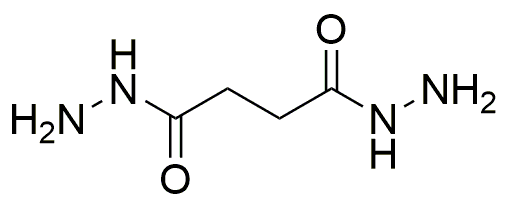Succinic dihydrazide is widely utilized in research focused on:
- Agricultural Chemistry: It serves as a plant growth regulator, enhancing crop yields and improving resistance to environmental stressors.
- Pharmaceutical Development: This compound is used in synthesizing various pharmaceuticals, particularly in the development of anti-cancer agents and other therapeutic drugs.
- Polymer Science: It acts as a crosslinking agent in the production of polymers, improving the mechanical properties and durability of materials used in coatings and adhesives.
- Food Preservation: Succinic dihydrazide is employed as a food additive to prevent spoilage and extend shelf life, particularly in processed foods.
- Analytical Chemistry: It is utilized in various analytical techniques, aiding in the detection and quantification of other compounds in complex mixtures.
General Information
Properties
Safety and Regulations
Applications
Succinic dihydrazide is widely utilized in research focused on:
- Agricultural Chemistry: It serves as a plant growth regulator, enhancing crop yields and improving resistance to environmental stressors.
- Pharmaceutical Development: This compound is used in synthesizing various pharmaceuticals, particularly in the development of anti-cancer agents and other therapeutic drugs.
- Polymer Science: It acts as a crosslinking agent in the production of polymers, improving the mechanical properties and durability of materials used in coatings and adhesives.
- Food Preservation: Succinic dihydrazide is employed as a food additive to prevent spoilage and extend shelf life, particularly in processed foods.
- Analytical Chemistry: It is utilized in various analytical techniques, aiding in the detection and quantification of other compounds in complex mixtures.
Documents
Safety Data Sheets (SDS)
The SDS provides comprehensive safety information on handling, storage, and disposal of the product.
Product Specification (PS)
The PS provides a comprehensive breakdown of the product’s properties, including chemical composition, physical state, purity, and storage requirements. It also details acceptable quality ranges and the product's intended applications.
Certificates of Analysis (COA)
Search for Certificates of Analysis (COA) by entering the products Lot Number. Lot and Batch Numbers can be found on a product’s label following the words ‘Lot’ or ‘Batch’.
*Catalog Number
*Lot Number
Certificates Of Origin (COO)
This COO confirms the country where the product was manufactured, and also details the materials and components used in it and whether it is derived from natural, synthetic, or other specific sources. This certificate may be required for customs, trade, and regulatory compliance.
*Catalog Number
*Lot Number
Safety Data Sheets (SDS)
The SDS provides comprehensive safety information on handling, storage, and disposal of the product.
DownloadProduct Specification (PS)
The PS provides a comprehensive breakdown of the product’s properties, including chemical composition, physical state, purity, and storage requirements. It also details acceptable quality ranges and the product's intended applications.
DownloadCertificates of Analysis (COA)
Search for Certificates of Analysis (COA) by entering the products Lot Number. Lot and Batch Numbers can be found on a product’s label following the words ‘Lot’ or ‘Batch’.
*Catalog Number
*Lot Number
Certificates Of Origin (COO)
This COO confirms the country where the product was manufactured, and also details the materials and components used in it and whether it is derived from natural, synthetic, or other specific sources. This certificate may be required for customs, trade, and regulatory compliance.

